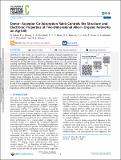Files in this item
Donor–acceptor co-adsorption ratio controls the structure and electronic properties of two-dimensional alkali–organic networks on Ag(100)
Item metadata
| dc.contributor.author | Sohail, B. | |
| dc.contributor.author | Blowey, P. J. | |
| dc.contributor.author | Rochford, L. A. | |
| dc.contributor.author | Ryan, P. T. P. | |
| dc.contributor.author | Duncan, D. A. | |
| dc.contributor.author | Lee, T.-L. | |
| dc.contributor.author | Starrs, P. | |
| dc.contributor.author | Costantini, G. | |
| dc.contributor.author | Woodruff, D. P. | |
| dc.contributor.author | Maurer, R. J. | |
| dc.date.accessioned | 2023-01-27T11:30:06Z | |
| dc.date.available | 2023-01-27T11:30:06Z | |
| dc.date.issued | 2023-02-09 | |
| dc.identifier | 283126603 | |
| dc.identifier | f256f565-ccf5-45a8-b638-b49dc6abc9a2 | |
| dc.identifier | 000925761700001 | |
| dc.identifier | 85147157772 | |
| dc.identifier.citation | Sohail , B , Blowey , P J , Rochford , L A , Ryan , P T P , Duncan , D A , Lee , T-L , Starrs , P , Costantini , G , Woodruff , D P & Maurer , R J 2023 , ' Donor–acceptor co-adsorption ratio controls the structure and electronic properties of two-dimensional alkali–organic networks on Ag(100) ' , Journal of Physical Chemistry C , vol. 127 , no. 5 , pp. 2716-2727 . https://doi.org/10.1021/acs.jpcc.2c08688 | en |
| dc.identifier.issn | 1932-7447 | |
| dc.identifier.other | RIS: urn:5493160C2528CB2FBBA5762984456C47 | |
| dc.identifier.uri | https://hdl.handle.net/10023/26842 | |
| dc.description | Funding: P.T.P.R. and P.J.B. acknowledge financial support from Diamond Light Source and EPSRC. G.C. acknowledges financial support from the EU through the ERC Grant “VISUAL-MS” (Project ID: 308115). B.S. and R.J.M. acknowledge doctoral studentship funding from the EPSRC and the National Productivity Investment Fund (NPIF). R.J.M. acknowledges financial support via a UKRI Future Leaders Fellowship (MR/S016023/1). | en |
| dc.description.abstract | The results are presented of a detailed combined experimental and theoretical investigation of the influence of coadsorbed electron-donating alkali atoms and the prototypical electron acceptor molecule 7,7,8,8-tetracyanoquinodimethane (TCNQ) on the Ag(100) surface. Several coadsorption phases were characterized by scanning tunneling microscopy, low-energy electron diffraction, and soft X-ray photoelectron spectroscopy. Quantitative structural data were obtained using normal-incidence X-ray standing wave (NIXSW) measurements and compared with the results of density functional theory (DFT) calculations using several different methods of dispersion correction. Generally, good agreement between theory and experiment was achieved for the quantitative structures, albeit with the prediction of the alkali atom heights being challenging for some methods. The adsorption structures depend sensitively on the interplay of molecule–metal charge transfer and long-range dispersion forces, which are controlled by the composition ratio between alkali atoms and TCNQ. The large difference in atomic size between K and Cs has negligible effects on stability, whereas increasing the ratio of K/TCNQ from 1:4 to 1:1 leads to a weakening of molecule–metal interaction strength in favor of stronger ionic bonds within the two-dimensional alkali–organic network. A strong dependence of the work function on the alkali donor–TCNQ acceptor coadsorption ratio is predicted. | |
| dc.format.extent | 12 | |
| dc.format.extent | 5069837 | |
| dc.language.iso | eng | |
| dc.relation.ispartof | Journal of Physical Chemistry C | en |
| dc.subject | QD Chemistry | en |
| dc.subject | NDAS | en |
| dc.subject | NIS | en |
| dc.subject | MCC | en |
| dc.subject.lcc | QD | en |
| dc.title | Donor–acceptor co-adsorption ratio controls the structure and electronic properties of two-dimensional alkali–organic networks on Ag(100) | en |
| dc.type | Journal article | en |
| dc.contributor.institution | University of St Andrews. School of Chemistry | en |
| dc.identifier.doi | https://doi.org/10.1021/acs.jpcc.2c08688 | |
| dc.description.status | Peer reviewed | en |
This item appears in the following Collection(s)
Items in the St Andrews Research Repository are protected by copyright, with all rights reserved, unless otherwise indicated.

